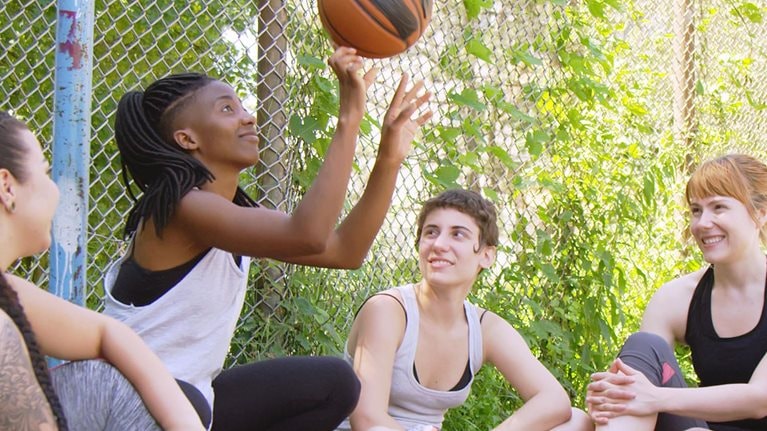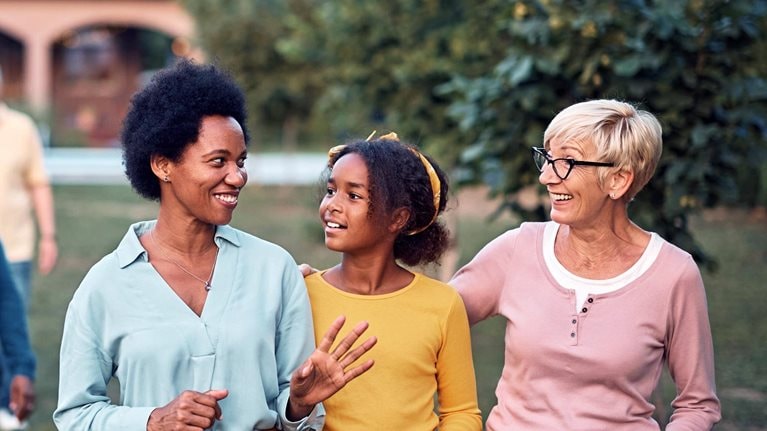In this edition of Author Talks, McKinsey Global Publishing’s Eleni Kostopoulos chats with Alex Jadad and Tamen Jadad-Garcia about their new book, Healthy No Matter What: How Humans Are Hardwired to Adapt (Penguin Random House, January 2023). Dr. Jadad created the widely popular Jadad scale for assessing clinical trials. Now, he’s combining his medical expertise with his daughter’s health entrepreneurship for a joint exploration into what it truly means to be “healthy.” An edited version of the conversation follows.
Why did you write this book, and why did you write it together?
Tamen Jadad-Garcia: For years, we worked together, questioning how things are traditionally done and pushing the boundaries of the healthcare system. Our mission has always been to enable as many people as possible to experience maximum levels of health.
We’ve done countless studies and led a huge number of projects around the world, and while we were doing that, we compiled a lot of lifesaving data and we generated truly lifesaving insights. This information would have been stuck within organizations. It would have been buried in academic articles and kept behind closed doors, out of reach for most people.

That’s one of the big impetuses as to why we wrote this book. We felt compelled to compile these lifesaving insights and make them as accessible as possible. In that effort, we wanted this book to become a companion for our readers. We wanted people to feel that they can revisit it throughout their life at different stages.
Alex Jadad: It’s really fun to do things together. We have been pushing each other’s boundaries for more than two decades. The playful nature of our interactions, even when we are dealing with some of the most serious subjects, generates messages that are more accessible and useful to those who read what comes as a result of our joint efforts.
Was there anything that surprised you during the research, writing, or response to the book?
Tamen Jadad-Garcia: There were a lot of opportunities for surprise. Going into it, we already had a long list of actionable, easy, and practical tools that people could use to boost their health, but as we started to dig deeper, this list grew massively. We were surprised by all the unexpected things that started to have greater potential than we thought.
For example, something as simple as a houseplant in your house or office space has been shown to reduce stress, improve sensations of calmness, sharpen your focus, and also improve the air quality in the spaces where you spend most of your time. In a hospital space, it can also speed up your recovery time, reduce your need for pain medications, and make you feel more satisfied with the care that you received.
One would expect a book on health to focus on the clinical, on exercise, or on healthy eating. We address that, of course, but then we go much broader than that. We present mental models and biological processes, and we shed light on tools and traps that are all around us.
Why is it important to understand how you feel about your own health?
Alex Jadad: Self-assessments of health are very important. In fact, they are essential if we are going to be healthy no matter what. But what is health?
We tend to think about health as the absence of disease, but we have been very privileged to have been part of an effort to reimagine the meaning of health. Instead of the absence of disease, we advocate for a position that views health as an ability: the ability to adapt to the inevitable physical, psychological, or social challenges that we face throughout our lives.
We advocate for a position that views health as an ability: the ability to adapt to the inevitable physical, psychological, or social challenges that we face throughout our lives.
Hundreds of studies have shown that we are able to judge our own level of health. What is even more wonderful is that it only takes one question, and this question goes as follows: In general, would you rate your health as poor, fair, good, very good, or excellent? That’s it. It takes about five to ten seconds to answer this question, and research shows time and time again that how you answer that question can capture things that not even blood tests can capture.
There have been studies on patients with cancer that show that their response to this question can predict, better than an oncologist can, whether that person would survive three or five years into the future. We have taken this even further.
We have been collecting data from millions of people from all over the world, and we have had the opportunity to ask people why they rate their health as positive or negative, and what they would need for their health to be experienced as positive. We have been delighted to see again and again that, in 90 percent or more of the cases, what we need to feel healthy goes beyond the boundaries of the medical system.

The secret to great health? Escaping the healthcare matrix
By focusing on health as an ability—the ability to adapt—and by focusing on our capacity to assess our own health, a lot of possibilities open. We can cultivate that ability, we can make it stronger, and we can explore many, many ways in which, even if we have diseases, we can feel healthy and be considered a healthy person.
Tamen Jadad-Garcia: If you’re not feeling well, you can think, “How do I rate my health? Why do I rate it that way? And what can I do to improve my levels of health?” We promote these three questions as something you can have in your back pocket to see whether you need to seek out support or whether you can manage it yourself.
What is the impact of toxic stress load on longevity?
Alex Jadad: Toxic stress load is a very powerful concept. It captures the baggage or scars that we accumulate as we go through our lives, facing and dealing with physical, psychological, or social challenges. This toxic stress load, or TSL, happens to all of us. It’s practically inevitable.
In fact, there are studies that even suggest that it accumulates across generations. If our grandparents, for example, have been traumatized, or have smoked a lot, we as the grandchildren can begin our lives with a much higher level of TSL. Rather than to escape from it, the key is to do everything in our power—and we can do a lot—to keep it at the very minimum, because this is what kills us prematurely: as TSL accumulates, it is equivalent to aging in a more accelerated way. In other words, the more we accumulate TSL, the older we are physically.
Every time we respond to a challenge, we get a little baggage. We get our scars. Whether they’re small, medium, or large, we get a trace of that response. Mounting a response to the challenges has a price, so we pay for the response we have.
Let me give you an example: you’re at work and you’re under lots of pressure. You have conflicts, you have a lot of things to do, and you have a lot of uncertainty. You cannot read very well what’s happening, so you feel very anxious about losing your job and your livelihood or damaging your reputation. That is a response.
Guess what? This anxiety also has some associated effects. You are less likely to eat healthy, you are less likely to exercise, you probably end up not sleeping that well, and this has a price. There is a price of staying awake and replaying what happened during the day or imagining things that could happen the next day. It adds to the TSL, and it has physical implications. It has the capacity to alter the arteries in your heart or the arteries that feed your brain. The chances of heart attack, stroke, diabetes, and even cancer increase as a result of this.
What role does the mind play in creating a healthy reality?
Tamen Jadad-Garcia: We believe that the mind plays a massive role in how we create a healthy reality. It shapes how we are able to adapt. Essentially, it’s the biggest source of our challenges and one of the biggest ways to overcome the obstacles that life presents us, so it’s twofold.
Your mind has a practically unlimited capacity to interpret something as stressful or fear-inducing, but you can also interpret the same context as calming, joyful, and welcoming. That’s what our brain can do. There are a lot of exercises that can help you chose the more favorable and optimistic perspective. It could be something as simple as trying to spot the happy face in all of the scared, angry, or confused faces, or filling in a word that’s either neutral or positive rather than one that is negative or threatening in the blank space of an ambiguous statement.
These kinds of exercises help to train your brain to choose the more constructive and positive interpretations of a context, and they have been shown to relieve anxiety disorders. These kinds of exercises are known as cognitive bias modification. Our mind has the ability to perceive itself, and it allows you to assess what you’re doing and who you are and create a feedback loop between those two things. You can create a healthier reality for yourself, and in the book, we give many examples of ways in which your mind can build this reality.
What role do our physical spaces play in creating a healthy reality?
Tamen Jadad-Garcia: Similar to our mind, our physical spaces can either contribute to or sabotage our healthy realities, either through their absence or by having certain characteristics that hamper our ability to thrive. The two established ones are green spaces and blue spaces. Green spaces are natural spaces for immersion in grasslands, trees, or other vegetation. These spaces have been associated with a 31 percent reduction in the odds of premature death from all causes. Something as simple as forest bathing can have huge health impacts.
Similar to our mind, our physical spaces can either contribute to or sabotage our healthy realities, either through their absence or by having certain characteristics that hamper our ability to thrive.
Blue spaces are the ones related to water, such as lakes, rivers, and even water coursing through a city. People living near the water or with a view of water experience fewer symptoms of mental distress and are generally more satisfied with their life.
These are the two established spaces. We expanded on them to include orange, violet, and red spaces. Orange spaces are the ones for the creative economy, like theaters, galleries, restaurants, and museums. We found that people who just visit a museum can curb their TSL. It helps them reduce social isolation and anxiety, and it improves positive emotions and boosts self-esteem.
In our society, we spend most of our time indoors. This is where the violet spaces play a huge role. We spend a huge part of our time in offices, residences, retail spaces, and educational institutions. This kind of physical space can impact our health potential, either by fulfilling basic human needs—such as shelter—or by helping us achieve a higher order self-actualization, like in the workplace and at school.
Finally, we have red spaces. These are the ones that are dedicated to healthcare services, but as we’ve been learning more about physical spaces, these red spaces are becoming a rainbow. They’re taking different elements from green spaces, blue spaces, and even orange spaces and putting them into one place so they can enhance the healing process. So, red is a bit of a rainbow now, and we can make our lives more of a rainbow with all the tech and mobility that we have.
What effect do you think the isolation experienced during pandemic lockdowns had on society?
Alex Jadad: Isolation is a huge issue. The extreme form of isolation is loneliness. This is an issue that deserves a lot of attention. For example, in 2019 in the US, ten thousand people were asked about their status, and 61 percent said that they were experiencing loneliness before the pandemic. This was a 7 percent increase compared with the year before.
As the pandemic hit, the numbers continued to go up, and the implications are really serious. Loneliness might be one of the most important sources of elevated toxic stress load. In fact, loneliness is associated with an increased risk of dying early. There are very few things in our lives that lead to an increased risk of dying early, and loneliness is way up there.
Before it kills you, loneliness increases the chances of pretty much every chronic disease, like heart disease or diabetes or cancer. It’s also associated with an increased risk of suicide, depression, and addictions. The good news is that we have an antidote for loneliness. It’s called companionship—to have at least one person with whom you could spend time.
In a paradoxical way, our digital technologies—which have been blamed to a large extent for many cases of isolation or loneliness—can also open new possibilities for us to connect with each other at the times when we need it most. We can develop a hobby together. We can discuss or participate in sporting activities together. We can advocate for causes that have relevance to us. That alone will get rid of loneliness, decrease TSL, and reduce the chances of dying prematurely or developing diseases.
The research on loneliness, companionship, and togetherness indicates that health is something that happens with others, and that it’s practically impossible to experience good health alone. There are ways to achieve it that are pretty feasible in almost every case, and under any set of circumstances.
The research on loneliness, companionship, and togetherness indicates that health is something that happens with others, and that it’s practically impossible to experience good health alone.
Are we doing enough when it comes to medical treatment, or are we doing too much?
Alex Jadad: In our book, a central concept is “enoughness.” Obviously, it’s possible to have too much of something, too little, or just the right amount. So we doctors are fully aware that doing more is not necessarily better. In fact, in many cases, doing more either has no effect or can do harm. This can happen on several fronts, and one of them has to do with testing.
There is a lot of over-testing in the healthcare system, in medicine. It’s to the point that 60 to 70 percent of the tests that are done in hospitals are either of no value to treat people or could be harmful, and yet we do it. We keep doing it, mostly motivated by the fear of litigation, so you aren’t regarded as incompetent for not ordering tests.
We also tend to overdiagnose because we feel safer giving names to things. We also have risks of overdoing things in terms of treating people. A clear example of this is antibiotics. We are using too many antibiotics for colds that are caused by viruses.
But there are other cases in which we might be doing too little, and risks are associated with that. For example, we are doing too little in terms of preventing the preventable. We all know that we should be eating in a different way, we could be exercising more, and we could be sleeping better, yet it’s not happening. It’s not that we don’t know; it’s that what we have available to change our behaviors is not powerful enough.
We are also facing challenges with what cannot be cured. We are doing too little in terms of chronic diseases, which end up consuming easily 90 percent of the healthcare budget now, anywhere in the world. We also have an opportunity to control the controllable. These controllable things are usually risk factors like high blood pressure or high blood sugar.
If these things are not controlled, they end up having very serious consequences, usually heart attacks or strokes. So how can we keep that balance? Perhaps the best thing we could do—and we emphasize this very much in the book—is to ask ourselves “Is this enough?” Are we doing enough in terms of testing? Are we doing enough in terms of diagnostics? Are we doing enough in terms of treatment? If the situation cannot be cured, are we trying to prevent, control, or relieve what could be handled?
Why is adaptability a key theme throughout this book?
Tamen Jadad-Garcia: Adaptability is the active capacity we have to change in response to threats, so that we become better suited and stronger and are able to thrive in new conditions. Without it, it’s not possible to feel healthy, because the challenges through life are absolutely inevitable.
Adaptability is the active capacity we have to change in response to threats, so that we become better suited and stronger and are able to thrive in new conditions. Without it, it’s not possible to feel healthy.
Essentially, we are hardwired to adapt. As we go through the book, we show that it’s our default to adapt rather than not to adapt. We are equipped culturally, socially, psychologically, and physically to do most of our adapting without even noticing it. We don’t even notice the challenge or response when we are adapting—we are that strong and adaptable.
This book is your guide to the various connections and functions that you have available for you to thrive. All in all, you are a formidable marvel—that’s our message—and wherever life takes you, you will be all right.
Watch the full interview



